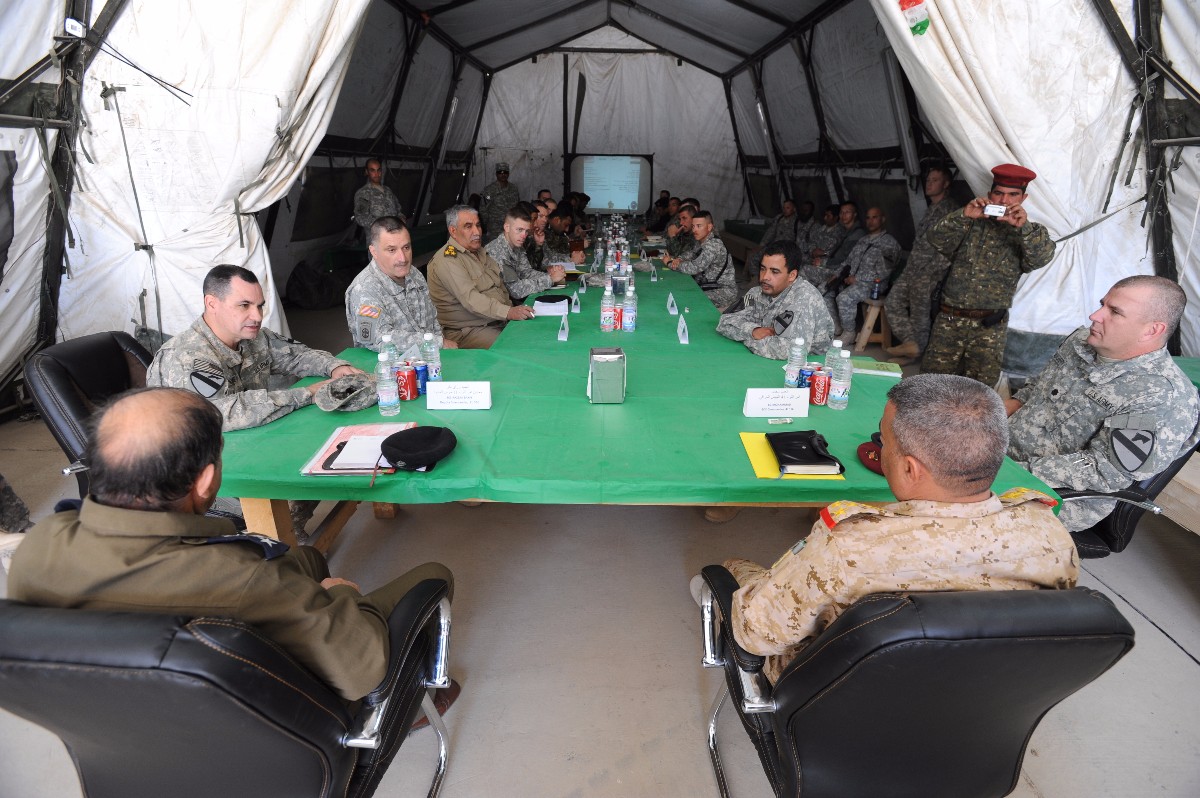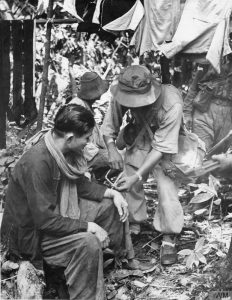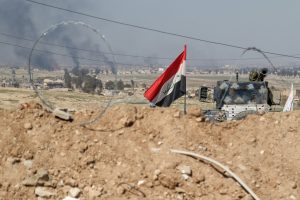 Iraqi security forces meet at Forward Operating Base Hunter (Photo: US Army)
Iraqi security forces meet at Forward Operating Base Hunter (Photo: US Army)
Post-Conflict Stabilization: Counterinsurgency After the Caliphate
The United States Military Academy’s Combating Terrorism Center released a report this week warning that as the Islamic State continues to lose territory, the group is beginning to revert back to the insurgent-based tactics its predecessors employed between 2003-2011. While the territorial defeats currently being suffered by the Islamic State are an important step towards its eradication, it does not eliminate the group’s ability to disrupt stability within Iraq and Syria in the post-conflict phase.
The report concludes that in many liberated zones previously held by the Islamic State, the group remains committed to waging a resistance—an insurgency against the liberating forces. To counter the Islamic State’s post-liberation insurgency, stakeholders involved in the post-conflict stabilization process must formulate a counterinsurgency initiative that relies on civil society efforts supported by military capabilities. Counterinsurgency strategies that rely too heavily on military capabilities or avoid civilian-based initiatives entirely rarely succeed.
Counterinsurgency Lessons

Suspected communist terrorists after capture by a Malayan Police patrol in the jungle. (UK Archives)
Western experience has proven that successful counterinsurgency strategies are generally predicated on an equal reliance upon military and civil oriented efforts, focusing on both the insurgents and the local population. The British experience in the Malayan Emergency was extremely successful because of their focus on “winning” the population and addressing the political, social, and economic grievances to co-opt the insurgency. These efforts were supported by a comparatively minor military initiative aimed at rolling back the insurgency while operating in direct support of the civil counterinsurgency efforts.
A decade later the United States failed to build upon the lessons learned by the British in Malaya or those of the U.S. Army in the Philippines and adopted an unsuccessful counterinsurgency strategy in Vietnam. It wasn’t until the United States partially adopted military strategies which were in support of local civil society-based efforts (e.g. CAP and CORDS) that successful counterinsurgency began to occur—unfortunately by then it was too late and these adjustments were never adopted military-wide.
Both the Malayan and Philippine cases are replete with examples of violence and brutality that would be unacceptable today. The lessons to be learned should not be the tactics themselves but rather the organizational learning and adaptation undertaken by both counterinsurgencies. Rather than continuing to rely on military force the counterinsurgents shifted towards civil society based initiatives focused on development and local enfranchisement. When the U.S. failed to recall these lessons in Vietnam, the results were unsuccessful.
Applying COIN Lessons Post-Caliphate
From a civil society and government standpoint, an effective counterinsurgency strategy will look to provide a level of stability and security that allows the local population to resume normalcy while improving quality of life through development initiatives as best it can. Therefore, police forces, with military assistance when required, will need to isolate the insurgent dominated areas to separate the local population from the insurgency. Local government officials should place an extreme value on intelligence provided by the local population and attempt to abide by a strict sense of decency towards those who come forward guaranteeing security and protection from retribution. These initiatives will require a degree of support from the military forces; cooperation between the two, however, should be the main priority.
Militarily, the focus should be on acutely targeting only the most substantial insurgent elements and preventing those insurgents from regaining territory, arms, and supplies. Unnecessary applications of military force can have a negative result and often turn local populations against the counterinsurgents. Rather than adopting large military operations to “root out” insurgents, as in Vietnam, the ideal approach would be small-unit operations acting on locally-sourced intelligence in pursuit of limited aims. Cumulatively, this low-risk, high-reward approach will result in a steady roll-back of insurgent influence and capabilities in key areas.

Explosions rock West Mosul, Iraq, during the offensive to liberate the city, March 6, 2017. (U.S. Army photo by Staff Sgt. Jason Hull)
As coalition forces continue to roll back Islamic State territorial control, and these former territories are subjected to some form of Islamic State insurgency, counterinsurgency efforts will need to adapt a cooperative approach that equally hinges upon both military and civil society initiatives.
While the United States may be inclined to act as a major participant in this process, the thrust of the counterinsurgency effort must be the Iraqi military. Moreover, Iraq must avoid using sectarian militias. The failure of Iraq to reconcile religious differences after the success of the Anbar Awakening warns against such a repeat. Iraqi security forces possess elite counterinsurgency forces well suited for the task. But expanding these forces and applying them judiciously to counterinsurgency operations without the supporting governance needed for post conflict environments could prove futile.






I was listening to the President’s speech tonight on Afghanistan, and heard him imply that the military units need to do military jobs, and not do ‘nation-building’. Then I re=read this article and wanted to make sure that how his new policy vision fits into this paper…